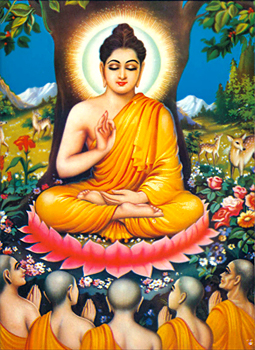 Principles of Buddhist Tantra mainly revolve around achieving enlightenment by identifying with Tantric deities. Tantra is a method through which the teachings are made concrete. Buddhist tantra is often associated with the Vajrayana sects of Tibetan Buddhism. Vajrayana is a complex system of Buddhist thought which has evolved over several centuries and its main scriptures are entitled as Tantras. Buddhist Tantrism is ritualistic in character. Tantric Buddhism has three main methods which include Deity Yoga, Guru Yoga and Death Yoga.
Principles of Buddhist Tantra mainly revolve around achieving enlightenment by identifying with Tantric deities. Tantra is a method through which the teachings are made concrete. Buddhist tantra is often associated with the Vajrayana sects of Tibetan Buddhism. Vajrayana is a complex system of Buddhist thought which has evolved over several centuries and its main scriptures are entitled as Tantras. Buddhist Tantrism is ritualistic in character. Tantric Buddhism has three main methods which include Deity Yoga, Guru Yoga and Death Yoga.
As per Tantric Buddhism tantra is a way to channel the energy of desire and transform the experience of pleasure into enlightenment. The "Four Purities" provide a sketch of basic principles of Buddhist tantra:
* One`s own body needs to be considered as the body of the deity
* One should consider one`s surroundings as the Mandala of the deity
* Enjoyment and happiness needs to be marked as happiness of the deity that has no attachments
* One should do everything which would be beneficial for others.
The practice of Vajrayana was the most successful way of attaining the goal of awakening. The teacher`s instructions are essential for practicing complex psychophysical meditation techniques. Mantras are used as an invocation to Lord Buddha. Mantras are repeated in order to create karmic connections between the practitioner and the deity. Practitioners awaken their own concealed probable for enlightenment.
Ritual plays an important role in Tantric Buddhism. It is an alternative for earlier conceptual meditations. The goal of spiritual practice is to become Lord Buddha by attaining complete enlightenment. All practices need to be undertaken with the motivation to achieve Buddha hood for the benefit of all living beings.
All Tantric practices are aimed at purifying impure perception of the practitioner so that he can visualize the ultimate truth. These include more advanced techniques of the Tantric sadhana. There are certain vows for the lower levels of tantra which are taken during initiations into the empowerment for a particular Anuttarayoga tantra. These vows vary depending on the specific Mandala practice for which the initiation is received. A Tantric guru is expected to keep his or her vows in the same way as his students.









